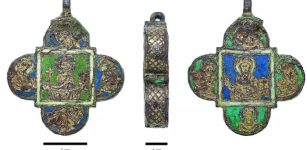Unique Medieval Spindle Whorl With Cyrillic Inscription Discovered In Poland
AncientPages.com - About 60 years ago, archaeologists excavating in Czermno, Poland discovered a unique spindle whorl.
At the time scientists did not notice the object was covered with seemingly chaotic lines forming an inscription.
Now, the artifact has been examined and it turns out that this is the only early medieval whorl found in Poland. It’s a precious artifact that was made in the second half of the 12th century or in the 13th century.
Spindle whorl adds weight to a spindle, prevents the threads from sliding off and maintains or increases the spin. Whorls come in different shapes - they can be spherical and biconical. They have a hole in the middle. They are usually made of clay, less often of stone.
This particular spindle whorl was made of the so-called Owrucz slate.
However, it has not yet been determined where the object came. It was found inside a settlement, but outside the buildings, which may suggest that it was lost.
The only early medieval whorl (a small, biconical object, a moving part of a spindle) with an inscription found in Poland has been discovered by archaeologists in Czermno (Lublin province). Credit: Science in Poland
“It is hard to say whether the whorl been made in Czermno or imported from the east, but it is certainly of Russian origin. Similar whorls covered with letters are known from the same period from the former Kievan Rus' territory, that is present Ukraine, Russia and Belarus,” researcher Iwona Florkiewicz from the Institute of Archeology of the University of Rzeszów said.
“The spindle whorl bears an inscription composed of 6 letters in Cyrillic, which can be transcribed as Hoten\'. It is a masculine name that means a lover, volunteer or master. It is also possible that the inscription was a toponym. In that case it should be associated with the name of a town or village. But researchers find this second possibility is less likely.
See also:
Crypts, Coffins, Artifacts And Wooden Church Remains Under The Floor Of Basilica In Poland
Renewed Excavations Of Unique More Than 5,000-Year-Old Megalithic Tomb Found In Poland
Giant 7,000-Year-Old Astronomical Calendar Discovered In Poland?
According to archaeologists, today's Czermno in the Lublin region was the historical Cherven - the administrative centre of the Cherven Cities, over which the Piasts had been fighting with the rulers of Kievan Rus' since the 10th century. Bolesław the Brave managed to recapture them in 1018, but after his death Yaroslav the Wise retook the territory in 1031. It was not until the 14th century that Casimir III the Great reincorporated the former Cherven Cities into Poland,” Science in Poland reports.
This makes scientists assume that the spindle whorl probably comes from the time when this area was a part of Kievan Rus.
"We are not sure whether the spindle whorl was used for its original purpose - spinning - or had a secondary function as an amulet. The latter possibility should not be ruled out" - Florkiewicz believes. She adds that according to the researchers, similar inscriptions could be signs of ownership. There are known spindle whorls that bear the names of women and men. "It is also possible that in this case it is the name of the object's maker" - she concludes.
The spindle whorl is currently in the collection of the Zamość Museum.
AncientPages.com





















